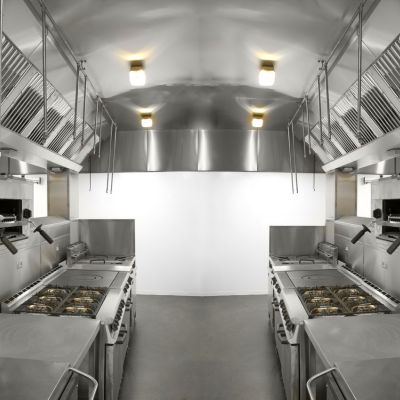Refrigeration equipment is a cornerstone of modern life, silently working behind the scenes in various industries to keep things cool and fresh. From preserving food to safeguarding critical medical supplies and maintaining comfortable indoor environments, the importance of refrigeration technology cannot be overstated.
In this post, we will explore the multifaceted world of refrigeration equipment. We’ll uncover the mechanisms, applications, and innovations that make refrigeration indispensable in the hospitality industry.
Types of Refrigeration Equipment
Refrigeration equipment encompasses a diverse range of cooling devices, each designed with specific purposes in mind. In hotel and restaurant settings, the selection of the right refrigeration equipment is paramount for ensuring the freshness and quality of ingredients. Let’s explore the primary types:
1. Refrigerators: These ubiquitous appliances are the workhorses of any kitchen. They maintain temperatures above freezing, ideal for storing fresh produce, dairy, and beverages.
2. Freezers: As the name suggests, freezers maintain sub-zero temperatures, preserving frozen foods for extended periods. In a restaurant, they are crucial for storing ice cream, frozen meats, and other deep freeze items.
3. Chillers: Chillers are precision cooling systems used in commercial kitchens and restaurants to rapidly lower the temperature of cooked food, ensuring it reaches safe storage temperatures promptly.
4. Air Conditioning Units: Beyond the kitchen, air conditioning units play a vital role in maintaining comfortable dining environments for patrons. They not only cool the air but also help control humidity.
Understanding the distinctions between these types of refrigeration equipment is fundamental to efficient kitchen operations and guest comfort. Each has a unique role to play in preserving the quality and safety of ingredients, ensuring that every meal is a delightful experience.
How Refrigeration Equipment Works?
Refrigeration equipment operates on fascinating principles of thermodynamics, essential for preserving perishable goods and creating comfortable environments. Here’s a glimpse into how these cooling marvels function:
1. The Refrigeration Cycle: At the heart of every refrigeration system is the refrigeration cycle, which involves the continuous circulation of a refrigerant. This cycle comprises four key stages: compression, condensation, expansion, and evaporation.
2. Compression: The process begins with a compressor, where the refrigerant is compressed into a high-pressure, high-temperature gas. This compression raises the refrigerant’s energy level, preparing it for cooling.
3. Condensation: Next, the high-pressure gas flows through coils or tubes located outside the cooling unit. As it loses heat, the refrigerant transforms into a high-pressure liquid.
4. Expansion: The high-pressure liquid then passes through an expansion valve, which causes it to expand rapidly. This expansion leads to a significant drop in pressure and temperature.
5. Evaporation: The cold, low-pressure liquid enters the evaporator coils or tubes inside the refrigerated space, be it a kitchen refrigerator or an air conditioning unit. As it absorbs heat from the surroundings, it evaporates into a low-pressure gas once again, and the cycle repeats.
6. Heat Exchange: Throughout this cycle, refrigeration equipment manages heat exchange between the refrigerant and the environment, effectively transferring heat from inside the unit (or space) to the outside. This continuous heat removal results in the cooling effect we experience.
Knowing these basic rules helps us understand how refrigerators work.
10 Applications of Refrigeration Equipment
Refrigeration equipment isn’t confined to just one industry; its cooling capabilities find diverse applications across several sectors. Let’s delve into some of these versatile uses:
1. Food and Beverage Industry: This is perhaps the most well-known application of refrigeration. Restaurants, supermarkets, and food processing facilities rely on refrigeration to store and preserve perishable items, ensuring food safety and minimizing waste. Walk-in coolers, freezers, and display cases are commonly used here.
2. Healthcare and Pharmaceuticals: Refrigeration is crucial for storing vaccines, medications, and medical supplies. The precise temperature control provided by medical refrigerators and freezers ensures the integrity and effectiveness of these critical items.
3. Laboratories: Research and medical laboratories utilize ultra-low-temperature freezers to store samples, chemicals, and biological materials. These specialized freezers can reach temperatures as low as -80°C, preserving sensitive substances.
4. HVAC Systems: Heating, ventilation, and air conditioning systems incorporate refrigeration technology to cool and dehumidify indoor spaces. Chillers and air handling units are central components of commercial HVAC systems, maintaining comfortable temperatures in offices, hotels, and hospitals.
5. Ice Production: Refrigeration equipment plays a vital role in producing ice for various purposes, from keeping drinks cold in restaurants to cooling industrial processes.
6. Data Centers: Modern data centers generate substantial heat due to their immense computing power. Precision air conditioning units use refrigeration to maintain the optimal temperature and humidity levels required to keep servers running efficiently.
7. Agriculture and Horticulture: Controlled atmosphere storage and refrigeration are used to extend the shelf life of fruits, vegetables, and flowers. This helps meet market demands year-round and reduces food wastage.
8. Energy Storage: Cryogenic energy storage systems, which use liquefied air or nitrogen, are gaining traction as a way to store excess energy generated by renewable sources for later use.
9. Aerospace: Cryogenic refrigeration is used to liquefy and store rocket propellants in the aerospace industry. Refrigeration ensures that these volatile fuels remain stable.
10. Residential Cooling: Residential refrigeration is common in households around the world. Refrigerators and freezers keep our food fresh and our ice cream cold.
The widespread use of refrigeration equipment underscores its significance in various aspects of modern life. Whether it’s ensuring food safety, preserving critical medical supplies, or creating comfortable environments, refrigeration technology continues evolving and adapting to diverse industries’ needs.
6 Emerging Trends in Refrigeration Equipment
The field of refrigeration equipment is experiencing a wave of innovation and transformation, driven by a growing emphasis on sustainability, energy efficiency, and smart technologies. Here are some of the prominent trends shaping the future of refrigeration:
1. Eco-friendly Refrigerants
One of the most significant trends in refrigeration is the shift towards environmentally friendly refrigerants. Hydrofluorocarbons (HFCs) with high global warming potential are being phased out in favor of alternatives like hydrofluoroolefins (HFOs) and natural refrigerants such as ammonia and carbon dioxide. These alternatives have a lower impact on the environment and contribute to reducing greenhouse gas emissions.
2. Energy Efficiency
Energy efficiency remains a top priority in refrigeration. New systems are designed with advanced insulation materials, variable-speed compressors, and smart controls that optimize cooling cycles. This not only reduces energy consumption but also lowers operating costs for businesses.
3. Smart Cooling Systems
The integration of Internet of Things (IoT) technology has led to the development of smart refrigeration systems. These systems can monitor temperature and humidity levels in real-time, providing precise control and early detection of potential issues. Smart refrigeration systems also enable remote monitoring and management, allowing businesses to respond promptly to maintenance needs and reduce downtime.
4. Thermal Energy Storage
Thermal energy storage solutions are gaining traction in refrigeration. These systems store excess cooling capacity during off-peak hours and release it during peak demand periods. This innovative approach reduces energy consumption during high-demand times and contributes to load balancing on the power grid.
5. Sustainable Design
Refrigeration equipment manufacturers are increasingly adopting sustainable design principles. This includes using recyclable materials, designing equipment for easy disassembly and recycling, and reducing the overall environmental footprint of the equipment’s lifecycle.
6. Trade Events and Networking
Staying updated with these trends is crucial for professionals in the refrigeration industry. Trade events, conferences, and exhibitions provide opportunities to network with industry experts, discover the latest innovations, and gain insights into emerging technologies. These events serve as hubs for knowledge exchange and collaboration, facilitating the adoption of cutting-edge refrigeration practices.
The refrigeration equipment industry is undergoing a profound transformation driven by sustainability, energy efficiency, and smart technologies. As eco-friendly refrigerants become the norm and smart systems enable precise control and remote management, the future of refrigeration holds great promise for reducing environmental impact, enhancing efficiency, and improving overall performance.
Concluding Thoughts
Refrigeration equipment stands as a cornerstone of modern life, playing a pivotal role across various industries, from food preservation and healthcare to HVAC systems. Its significance cannot be overstated, as it ensures the safe storage of perishable goods, maintains critical temperatures for medical supplies, and offers comfort in our homes and workplaces.








